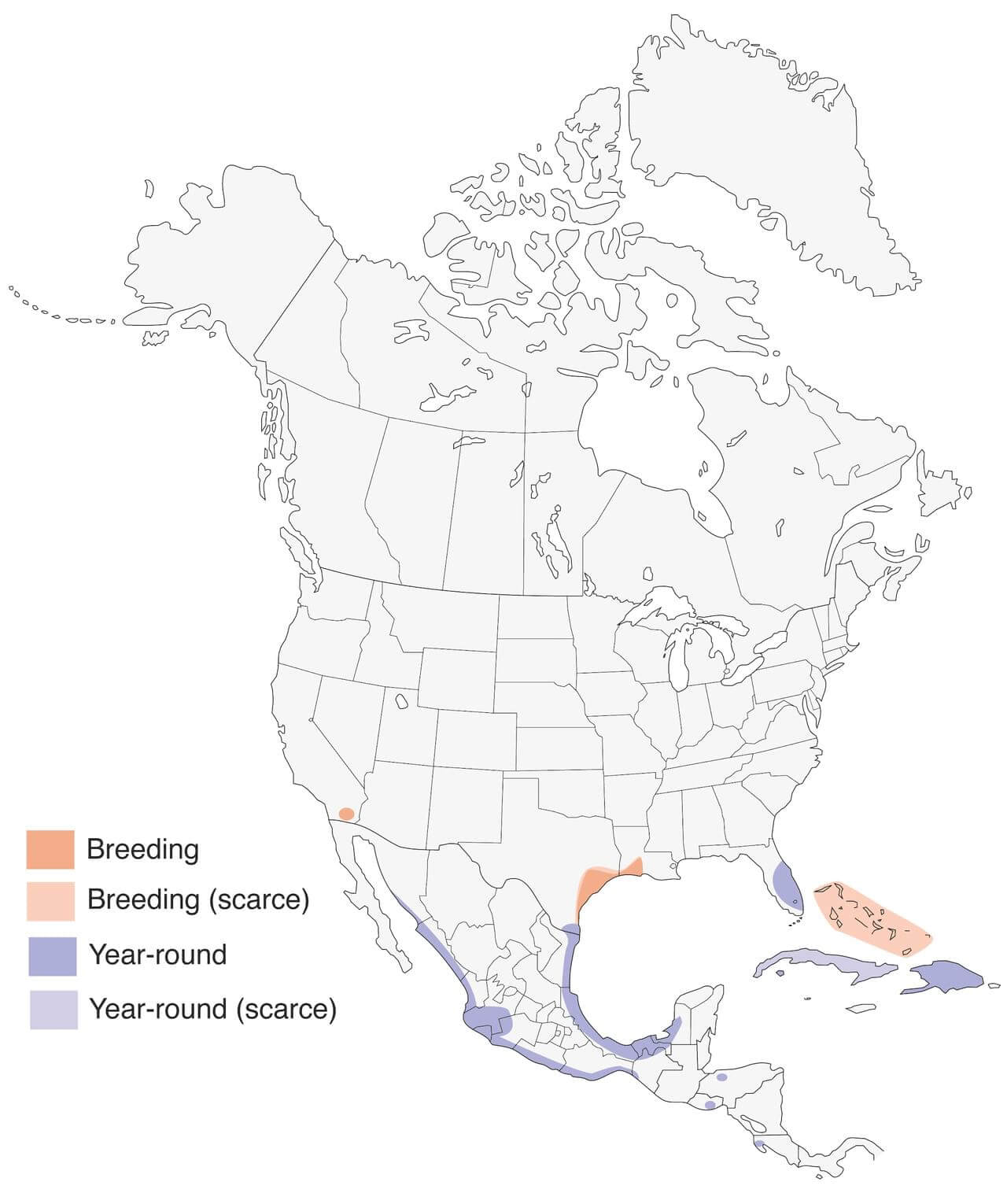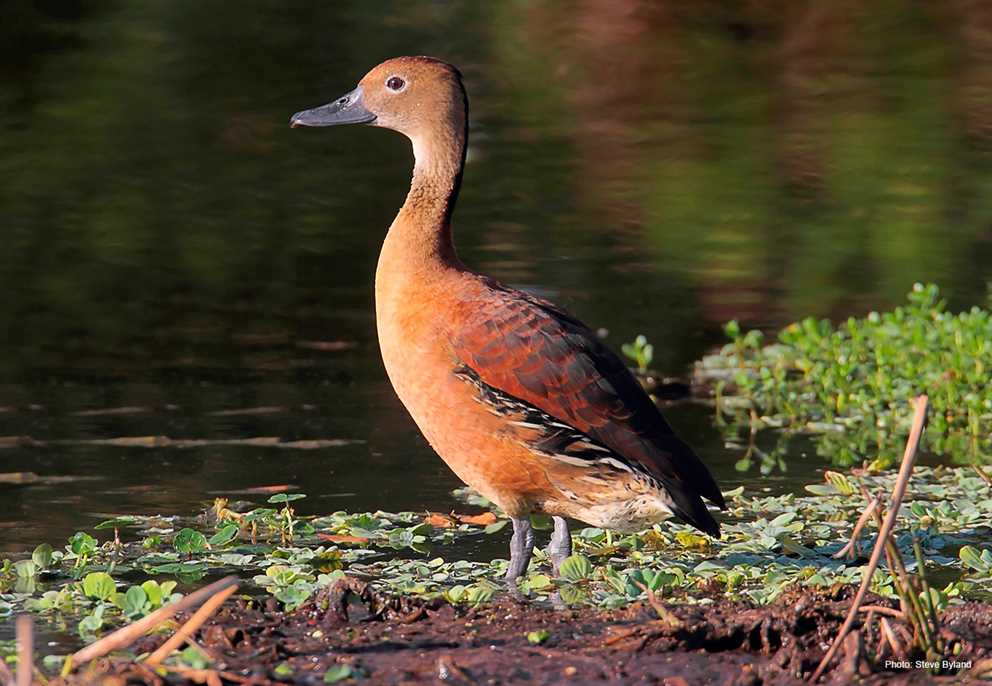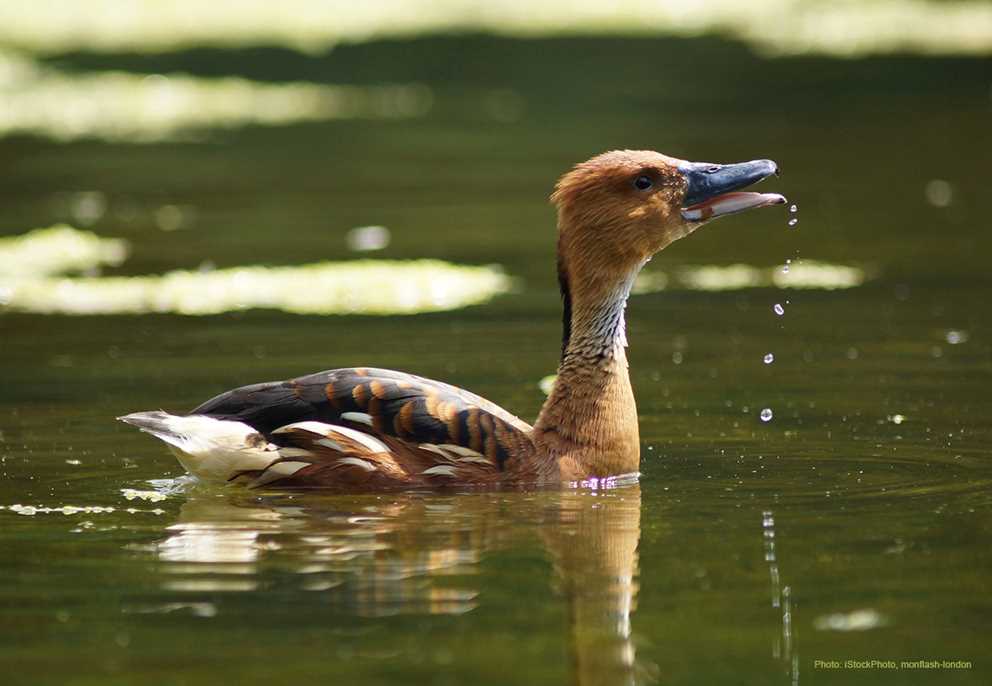Overview
The Fulvous Whistling-Duck is a medium-sized tropical species that occurs in North and South America, Africa, and India to Myanmar. In North America, it occurs in extreme southern California, Mexico, coastal Texas and Louisiana, and the lower half of peninsular Florida. Fulvous Whistling-Ducks are unmistakable in appearance, and the sexes are identical. Perched on the ground or in trees, they have an erect posture, a blue-gray bill, and gray feet. They are tawny overall, the head has a dark crown, and the back and tail are blackish brown with tawny scalloping, both of which contrast with the white rump band. The grayish neck has darker streaking that suggests a furrowed appearance. The flank and belly are tawny cinnamon. In flight, the wings are deep brown, and crescent shaped white rump is notable.
Description
Key Identification Features
- In flight, the wings are deep brown, and crescent shaped white rump is notable.
- Flight strokes are slow, with the neck stretched outright, and feet extended beyond the tail, and the white rump forms a crescent that contrasts with back and tail.
- The grayish neck has darker streaking that suggests a furrowed appearance. The flank and belly are tawny cinnamon.
Male/Female Average Length and Weight
- Weight: Males and females overlap in mass and range 1.2–2.1 lbs.
- Wingspan: 8.2–8.4 in.
Male and Female Identification
- Alternate (Breeding) and Basic Plumage: They are tawny overall, the head has a dark crown, and the back and tail are blackish brown with tawny scalloping, both of which contrast with the white rump band. The bill and feet are dark gray blue. The grayish neck has darker streaking that suggests a furrowed appearance. The flank and belly are tawny cinnamon. In flight, the wings are deep brown, and crescent shaped white rump is notable. Flight strokes are slow, with the neck stretched outright, and feet extended beyond the tail, and the white rump forms a crescent that contrasts with back and tail.
In-flight Identification
- In flight, the wings are deep brown, and crescent shaped white rump is notable. Flight strokes are slow, with the neck stretched outright, and feet extended beyond the tail, and the white rump forms a crescent that contrasts with back and tail.
Vocalizations
- Very vocal. A high pitched, “kit-tee” or “pee-chee” accented on the second syllable.
Similar Species
- Black-bellied Whistling Ducks: Adults are unique and unlikely to be confused with any other species of waterfowl in North America. Juveniles resemble juvenile, Black-bellied Whistling Ducks, but Fulvous Whistling Ducks lack the presence of white wing patches that easily separate the two species.
Habitat Preferences
- Fulvous Whistling-Ducks are typically found in freshwater wetlands, ponds, or lakes, usually with emergent or floating vegetation, and often in rice fields and flooded pasturelands.
Foraging Habits and Diet
- Fulvous Whistling-Ducks are vegetarian with a diet often greater than 95 percent plant material. Vegetation consumed includes seeds of various emergent and aquatic plants. They also feed on cultivated rice. Invertebrates are usually less than 5 percent of the diet but include mussels and various aquatic insects.
Breeding Habits
- Monogamy: Fulvous Whistling-Ducks maintain monogamous, lifelong pair bonds.
- Nest Locations: Nests are often over water in dense flooded emergent or floating vegetation, and they also may nest on the ground.
- Clutch Size: The average clutch size in Louisiana was 14.1 eggs, with much larger clutches resulting from dump nesting or intraspecific nest parasitism. The eggs are white to buffy white, bluntly ovate to oval and average 2.1 by 1.6 in. The incubation period is about 24–25 days with males and females alternating incubation of the eggs
Migration and Distribution
- They are mostly sedentary in Florida. Departs Louisiana and northern areas of coastal Texas August to October. Migrants overwinter in coastal areas of Mexico and return to breeding areas in late March or April.

Conservation Status
- IUCN Status: Least Concern
- Population Status: Global estimates are 1 million in North and South America, 1.1 million in Africa, and less than 20,000 in Asia.
- Conservation Concerns: The primary threats include habitat loss and climate change.
- Conservation Focus: Conservation efforts focus on protecting and restoring habitat.
Harvest Information
Harvest is believed to be extremely low and is estimated to be below 5,000 annually with the most harvest occurring in Florida, Texas, and Louisiana. Harvest is low in part because Fulvous Whistling-Ducks depart their breeding areas before most waterfowl hunting seasons open.


